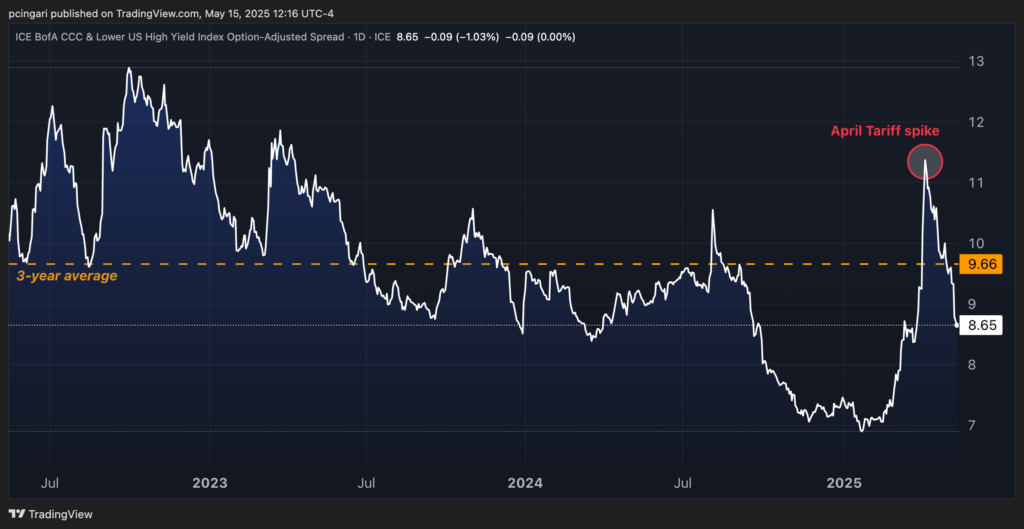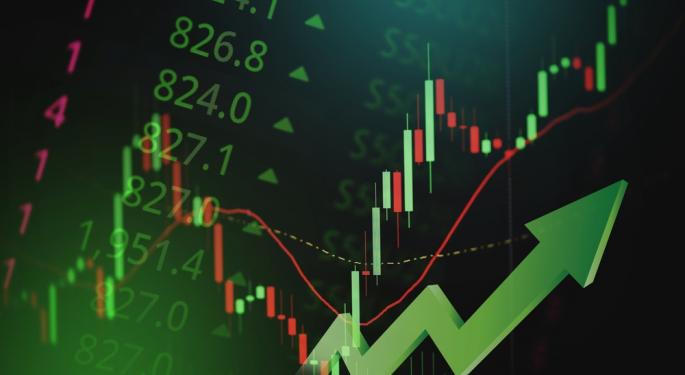What Recession? Markets Have Erased Every Last Bit Of Economic Pessimism
Five weeks ago, markets and businesses were bracing for the worst. Donald Trump's sweeping April 2 tariff announcement sparked panic across equities and credit markets, igniting fears of a trade-driven recession.
But fast forward to mid-May, and the last traces of that economic pessimism have been wiped out. From credit spreads to the traditional Wall Street’s stress indicator, the message is clear: Investors are no longer pricing in a U.S. recession.
Tariff-Driven Credit Risk? Gone
High-yield bond spreads — one of the market’s most reliable gauges of economic stress — have returned to pre-tariffs levels.
The spread between U.S. high yield corporate bonds and Treasurys has dropped from 4.7 percentage points in early April to just 3.1 percentage points, now below the three-year average of 3.86. This signals investor confidence in even the riskiest borrowers' ability to meet debt obligations.
“During a huge risk-on advance, US High yield spreads have tightened 152 bps since April 7. With spreads now at 309 bps above Treasuries, credit market investors are back to pricing in a very optimistic outlook with no recession and few defaults,” Charlie Bilello, chief market strategist at Creative Planning, wrote in a post on X.com.
Even in the riskiest corners of the market, sentiment has flipped.
CCC-rated bonds, which sit just above default status, now trade at an 8.74-point spread, down from an April 7 peak of 11.4, and well below their 3-year average of 9.66.
The BondBloxx CCC-rated USD High Yield Corporate ETF (NYSE:XCCC) has rallied 13% since April 7, marking the best 26-day rise since the fund’s inception in 2022.
This reset in credit risk pricing reflects not only a shift in sentiment but also the market's perception that tariff-induced recession risks have been neutralized.
Chart: Junk Bonds Are Breathing Easy Again After Tariff Shock

Volatility Vanishes As Wall Street Gets Its Calm Back
The CBOE Volatility Index (VIX) — Wall Street's fear gauge — had spiked to 60 on April 7, a level not seen since the pandemic crash.
But with the White House’s 90-day pause on tariffs and tangible diplomatic progress — including a May 12 U.S.-China trade truce and a May 7 U.S.-UK trade agreement — clarity returned, and with it, calm.
On May 15, the VIX hovered around 18 levels, marking a 70% drop from last month’s peak.
“Clarity often breeds comfort, and the removal of worst-case trade war scenarios meant the market could move on from peak fear,” said in an email Adam Turnquist, chief technical strategist for LPL Financial.
Dominic Wilson, analyst at Goldman Sachs, said the reduction in China-U.S. tariffs has led the bank to raise its U.S. growth forecast and lower recession odds.
"We see some scope for near-term relief to continue," Wilson said, although he warned about renewed pressure on long-term interest rates and called for downside protection ahead of labor data.
CFTC-regulated betting platform Kalshi now assigns a 40% probability of a U.S. recession this year, down from 70% a month ago — suggesting it's now more likely the economy avoids a downturn.
Markets Enter Phase 2: Communication Services, Tech Lead
Markets are now transitioning into what Jeff Buchbinder, LPL Financial's chief equity strategist, calls "phase two" — a low-tariff, trade-clarity regime.
During this period, sectors exposed to global supply chains and discretionary spending are expected to outperform, according to the expert.
Buchbinder said communication services, consumer discretionary, industrials, and technology top his list, with the former seen as the standout.
The communication services sector has the highest percentage of cost of goods sold sourced outside the U.S. among S&P 500 sectors, as LPL noted citing Bloomberg data, making it a prime beneficiary of easing trade tensions.
The sector also boasts the lowest price-to-earnings ratio, biggest first-quarter earnings upside surprise, and second-best earnings growth among all 11 S&P sectors.
From collapsing volatility to tightening credit spreads and a bullish sector rotation, markets are sending a clear signal: recession fears are in the rearview mirror, at least for now.
Read now:
Photo: Shutterstock
© 2025 Benzinga.com. Benzinga does not provide investment advice. All rights reserved.
Posted-In: Analyst Color Equities Government Large Cap Macro Economic Events Bonds Specialty ETFs Top Stories



